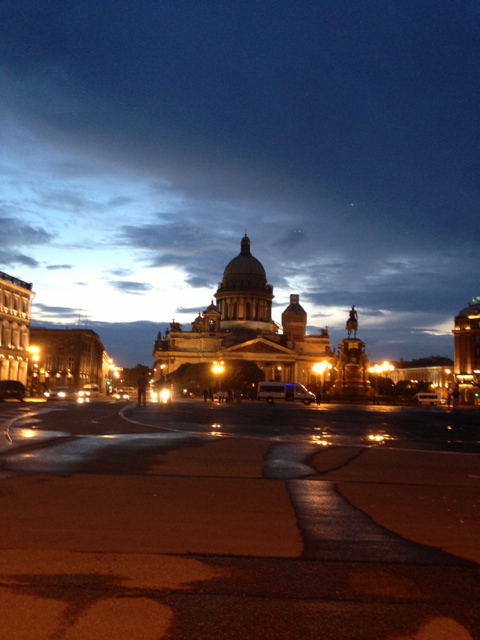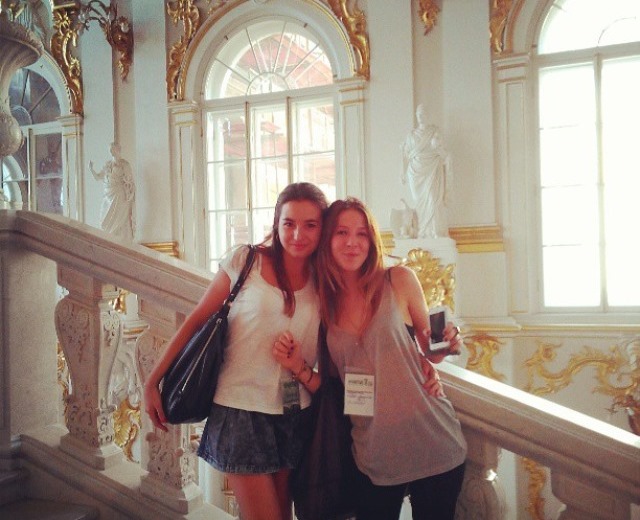Voices from Abroad: Sofia Pandolfo
St. Petersburg (Russia), International Internship: The State Hermitage Museum
3am, amazing daylight surrounding my eyes, the sky was still as bright as that of an early summer evening in Milan and I was standing in front of one of the most majestic Palaces in the whole world: I discovered the golden side of Petersburg!
 White nights: Saint Isaac's Catherdral |
In Saint Petersburg, the grand city of the czars, they call them the ''White Nights:': those eighty or so evenings, running from May to the end of July, when the city emerges from long months of cold and darkness and celebrates the return of nearly round-the-clock daylight. Residents of Russia's cultural capital and artistic epicenter have been welcoming the summer with celebration ever since Peter the Great founded the city in the early 18th century.
St. Petersburg is a city of lights and shadows that turns out to be even more interesting once you have the lucky chance to live there and breathe that bittersweet atmosphere typical of an Eastern European capital. It is not only about finding out places you would not see as an ordinary tourist (such as the innovative Loft Project ETAGI), but living in the ex Leningrad that teaches you (and I am talking about the human side of the experience, the most relevant one!) things you would never learn and appreciate otherwise. I tested myself living in a typical коммуналка (Russian for kommunalka), the communal apartment from the Soviet Union: these flats were the predominant form of housing in the USSR for generations and they still exist as cheap/not too expensive accommodation in the city. Also, I experienced the local perception of concepts like "communication," "smile," and, most of all, "transparence" and how different they are from those of a 22-year-old Italian girl.
What will surprise you the most anyway is the intimacy you come to feel after a few months with the place: when you go down Nevsky Prospekt, when you cross the Moyka canal, when you finally spill into the vast, black Neva river and all of the city spreads before you, pink and violet clouds streak the horizon and you realize that breathtaking location is the best frame for a place that marked the political and human history of the last two centuries.
My first steps into the city were not so sweet; but even though communication wasn't always fluent with the locals, a few days were enough to understand all the difficulties were way much more worth it than I thought at the beginning.
In fact I just had to enter my workplace to figure out the fortune I had, getting so close to many relevant and meaningful pieces of art, walking freely throughout the corridors of the Winter Palace (I now know the palace like the back of my hand and it is an honor) and having the privileged access to the area (I had the opportunity to enjoy the Museum from the "inside" and that was invaluable).
 Sofia during her internship at the museum |
As an intern at The State Hermitage Museum I was involved in many different tasks: I helped in different scientific departments, with the organizing of conferences and special museum events, with the translation and editing of texts and writing articles for the Hermitage newspaper and website; I also corresponded with educational and cultural institutions and helped the International Department including meeting guests of the Museum. Moreover, I have been part of an intriguing project with the preparation of information for an application software regarding the interactive guide tour project. Therefore the job itself has been a great experience and I have learnt so much, not considering the feeling of being (even with a small role) part of the organogram that manages and curates one of the largest and oldest museums and collections in the world and to to see how it works.
Leonardo, Rafaello, Michelangelo, Tiziano, Rembrandt and up till the third floor (the one I used to call the "dream floor") with the masterpieces of the 20th century (Cezanne, Renoir, Monet, Manet, Gauguin, Van Gogh, Matisse, Picasso) together with the Hermitage itself: a once-in-a-lifetime chance!
I have also noticed how sacred the place is for every single Russian citizen and how respectfully they act towards the Hermitage and, in wider terms, towards their cultural and artistic patrimony. This is something that made me, and makes me every day, meditate on my country and on how we behave and manage our heritage, how less aware we are of the heritage we own.
In addition to that, while I was there, at the end of July, the Mayor of Venice, Giorgio Orsoni, and the Museum General Director, Mikhail Piotrovsky, signed a Protocol of Intent between the State Hermitage and the Municipality of Venice on the terms of organizing and implementing a cooperation project on the program for the academic and cultural center "Hermitage-Italy," and, since I am from Venice, I was so excited to participate to this crucial moment hoping for this to be a first step of a general increase of awareness and initiative for my country, Italy.
Finally, I totally recommend this experience, not just because of The State Hermitage Museum and the job opportunity you will get (what more can I say?), and not only because of the experience of living in a beautiful and alienating city such as St. Petersburg, but mostly because if you are Italian you will feel an incredible connection with that city. This is probably due to the fact that a lot of Italian minds have been involved in working in the city (just think about Bartolomeo Rastrelli, the architect who designed the Winter Palace, or Carlo Rossi, the one who designed the Palace Square later...), and there you will appreciate a respect for culture and for Italy that is much deeper and higher that the one Italians themselves have: this is going to make you want to change something!